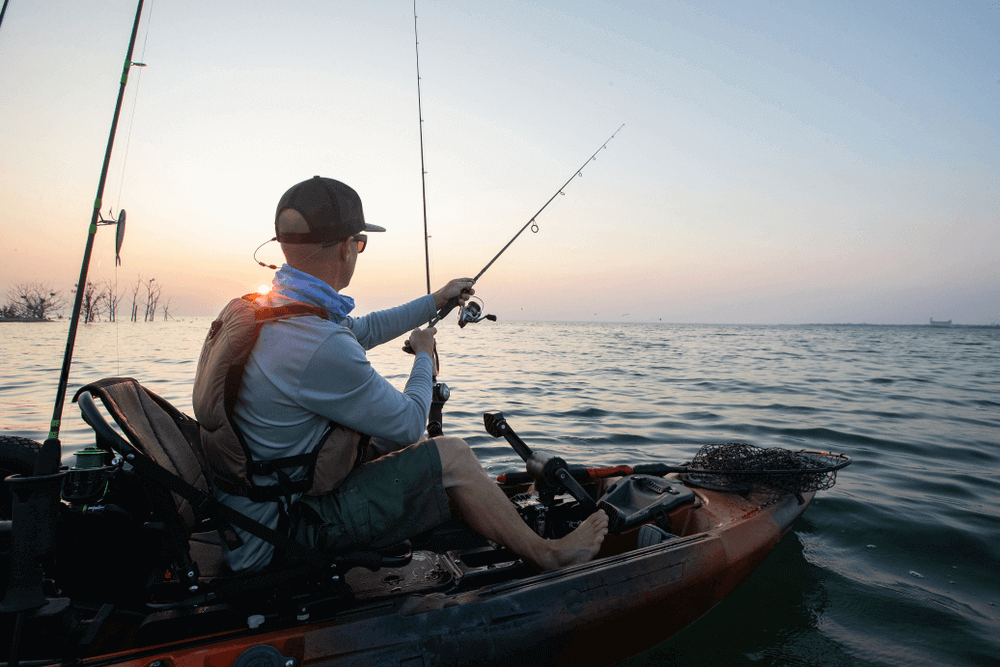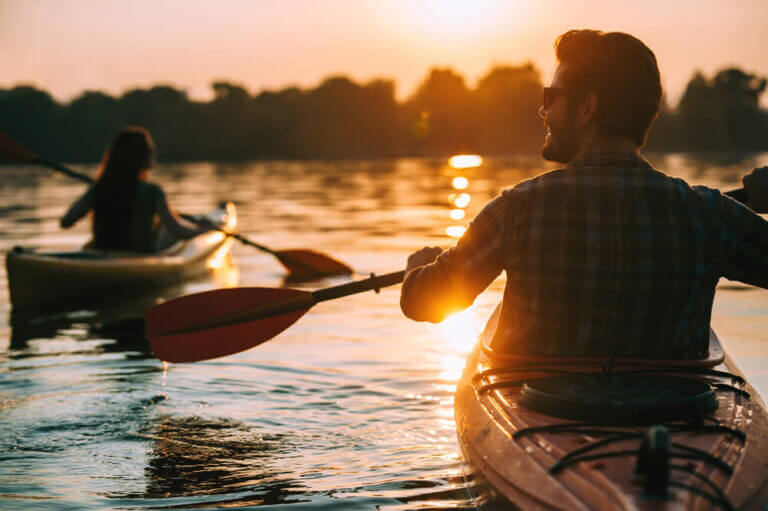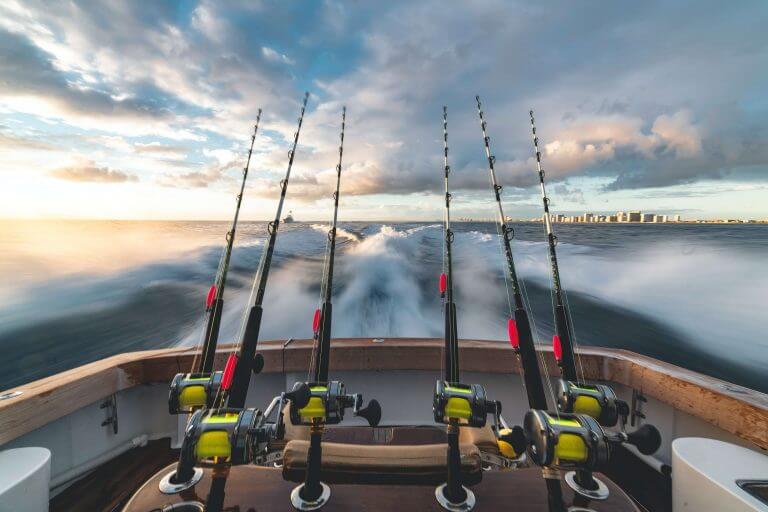How To Outfit A Kayak For Fishing
In the fishing industry, fishing kayaks are currently the hottest thing since sliced bread. You can’t walk into a tackle shop, sporting goods store, or internet forum without seeing anything about chasing little finned creatures from a fishing kayak.
People like you are probably wondering, “How can I improve my fishing kayak?” The ‘Ultimate Fishing Machine’ is more about personalizing your kayak to your specific wants and fishing style than anything else.
The most popular kayak among anglers is a sit-on-top kayak. They are very stable boats with a lower learning curve regarding proficiency and safety than sit-in fishing kayaks. They even build versions that are sturdy enough to fish from it.
Equipping a kayak for fishing is similar to outfitting any other watercraft. The most challenging obstacle to overcome when outfitting a fishing kayak is a lack of space. But don’t worry; there are plenty of accessories that will work perfectly on a kayak.
Let’s look at the kayak fishing necessities that every ultimate kayak fishing setup should have. And what you’ll want to bring with you in your kayak to make your days more fun!
How to outfit a kayak for fishing
It’s not tricky to outfit your kayak. You may choose from a range of products, with the essential items being very reasonable. Let’s take a look at some of the gear you’ll need to go fishing.
Holders for rods
A rod holder is an essential tool to keep your fishing rod secure, whether paddling, trolling, or fishing in your kayak. Rod holders exist in various shapes and sizes, and some fishing kayaks even have them built-in.
The following are the main types of rod holders:
- Adjustable rod holder
As the name says, they may be changed in height, and some can even be turned in a full circle, with the added benefit of being removed when not use.
- Flush-mounted rod holders
These varieties are simple to manage and discreet because they may be readily integrated into the kayak by inserting a tube or shaping it. They usually are located behind the kayak and, depending on the model, can be removed.
Anchor
Kayak anchors are pretty light and can have a wide range of features. The main point is that you should be able to remain in one location when necessary.
Using an anchor may not be possible or practical in some scenarios. It’s preferable to use a drift chute here, so you don’t drift too much when trying to fish in one spot.
Ensure you have a tiny anchor you can use to fish for a specific location or structure type. For example, an anchor will help you maintain your kayak in one spot when fishing near the river or in windy conditions.
1.Anchor Main
There might be several types of the main anchor. Two types of pliers and claw anchors at hardware shops are most frequent.
2.Folding anchors
These are the most popular anchor kinds since they are portable and may provide you with a firm hold in many situations.
3.Claw Anchors
These are not as portable as your folding anchors but are best to keep you safe, especially when your lake/river bed is very soft.
Seats
The type of seat you have installed determines how much fishing you can do in a kayak. The seat is especially vital if you want to go fishing for the entire day.
You can fish longer and more comfortably if you acquire a comfortable seat. However, don’t try to cut corners on the seat’s quality to save money. You won’t be fishing efficiently if your seat is uncomfortable, and you might even harm your back.
Drift chute
You’d need to put your kayak on a drift chute when you wish to fish in water too deep to be efficient anchors. Then, if you start fishing drifting, you can use it to slow down. The proper use of drift chutes will also make it hard for fish to throw you around if you catch a huge one.
Organizing your gear
Different boats will have different organizational and storage possibilities. No matter what, dry bags are required. The majority of your rods and gear should be stored in the rear tank wells. If your boat has a center console, it’s perfect for compact tackle boxes that allow you to swap lures and bait quickly.
Because we’re talking about being out on the vast ocean, frequently alone. The front of the boat is often the best place to store a bilge pump, emergency kit, supplementary floatation devices, and other just-in-case gear.
Navigation lights
If you’re fishing at night or during low light hours such as dawn and dusk, a white portable navigation light should be installed on your kayak.
Something to Keep Your Paddles Secure
When you cast, you can’t hold your paddles, and you don’t want them to drift away. Most kayaks have a spot to keep the paddles, but adding rod holders can make it challenging to keep your paddles in position.
Make sure you have a paddle holder or a paddle leash to keep your paddles safe when fishing. Also, make sure you don’t end up on the lake without a paddle, no matter how you do it.
GPS/ Fishfinder
Small 4-inch or 5-inch GPS/fishfinder systems work for kayaking because they don’t have much room. These compact fish finders are also easier to attach to a kayak but don’t forget to hook it to a naval power batteries unless you’re using a portable fish finder
Personal floating device(PFD)
It is vital to have a PFD (or a life jacket) when doing kayaking for anything. Certain PFDs are specially developed for kayaks so that the movement of the high body is not restricted during paddling. In addition, some PFDs feature storage compartments to store tools such as pliers or tackle boxes.
Other Essential Fishing Equipment
The following are some other items you’ll need in your kayak:
Tackle boxes
When looking for the best tackle box for your kayak, look for a waterproof style that will keep your baits, hooks, and tackle dry. In addition, the best tackle boxes are small and lightweight. If you want to fly fish from your kayak, you can even keep small boxes of flies or leader material in the pockets of your life jacket.
Multi-tool
You must always deal with enclosed lines and remove hooks during fishing. A muti-instrument is usually the most pleasing way to make your life easy with a set of pinches, different types of blades, and other various instruments. Some pesticides often use nail clippers to cut lines and needle-nose hairpin to remove hooks. But you can carry fewer devices with a multi-tool, but you can be ready for practically anything.
Communication Devices
When kayaking, it is likely to be you alone in your kayaking system. But, most of the time, we are saying that since tandem kayaks are very well-suitable for group fishing – and as with all sports and living situations generally, crises may develop.
Lantern
Fish are known to be more active around dawn or dark season and look for food. A guided lantern can help you detect obstacles and the ability to manage and find all your equipment correctly. At the same time, you are in the Dark if you want to fish in the sun at all.
Dry Clothes
Within the water, you go fishing on a boat that can flip at any moment. With a dry piece of clothing, you can comfort your journey back home and decrease your risk of acquiring cold or flu due to exposure to wet factors.
First Aid kit
it is typical to cut some fishing once in a while, with you a little first aid kit that helps you clean up your injury to prevent infection, heal your headache, and more. The first aid kit is also available for anyone. Just imagine all that may happen during fishing, and arrange all the first aid things you may need in a bit of a compartment.

Tips for Kayak Fishing
Kayak fishing can be performed in several ways.
- You can troll for crappie or other panfish by using a spider rig setup.
- You could quickly fly fish from one if you had a sit-on-top that allows you to stand.
- Fly fishing from a sit-in is possible, but it is usually inconvenient.
- Additionally, you can use your spinning rod or bait caster to cast and retrieve, utilizing the traditional cast and retrieve approach.
- Sight fishing is also possible, particularly during the bass spawn.
Frequently Asked Questions
Is it possible to mount a rod holder on a kayak?
That’s fine because your kayak can easily be converted into a new fishing machine. A YakGear Flush Mount Rod Holder Kit is a terrific place to start. They’re usually positioned at a 45-degree angle, so you can readily reach your kayak’s rear tank well storage or use them for trolling.
Is it difficult to learn to kayak as a beginner?
Kayaking is not as challenging to learn as you may believe. However, to paddle efficiently, you need a few basic skills. For example, to learn how to enter and exit a kayak, perform the forward and sweep strokes for turning the boat. And a few safety courses, you’ll need a good guide or instructor.
What is the procedure of using a fishing kayak?
Remember, its job is to transport a kayak angler to various fishing spots and give a fishing platform. Sit-on-top kayaks with a large, open cockpit and closed compartments in the bow, behind the seat, and in the stern are almost exclusively used for fishing.
What can we do to improve the stability of the fishing kayak?
Ensure equal weight distribution is one of the finest strategies to improve your overall stability in the water. Your seat is being lowered. Purchase a stabilizer. Try paddling in a different kayak. When using a two-seater, pay attention to the weight. Consider a sit-on-top, short kayak. It is said that practice makes perfect.
Could you personalize a kayak?
Because many kayak alterations are based on personal preference, not all mods will fit everyone. But that’s the appeal of personalization: whatever you do to your kayak can be tailored to your preferences. As a result, you’ll be able to design your ideal boat.
Does color matter in kayak fishing?
The kayaking color has nothing to do with fishing. Some anglers argue that bright colors such as gel, green, orange, and camo are the most incredible options in clear water and can attract fish, even if we don’t endorse this viewpoint. The only color white can speak about fish.
How can I improve my kayak fishing skills?
Kayak anglers that are successful modify their approaches accordingly. Use lures that are adaptable and simple to catch. Use search baits such as spinnerbaits, swimbaits, and crankbaits to locate fish. Before leaving an area, switch methods to target different species. To cover water to casting, a troll from a kayak.
Conclusion
Kayak fishing is a wonderful way to get out on the lake and spend some time in nature. It’s not only a fun and peaceful way to get outside, but it’s also a terrific way to get some exercise. Paddling around a lake all day is no easy task, but if you do it regularly, you’ll notice the benefits.
Kayaking for fishing is a fantastic experience, but there are a few things you should remember to pack. Kayaks don’t have the same setup as boats or land-based fishing, so it may take some time to figure out precisely what you want to bring. However, once you’ve had some experience with kayak fishing, you’ll realize how enjoyable it can be.







